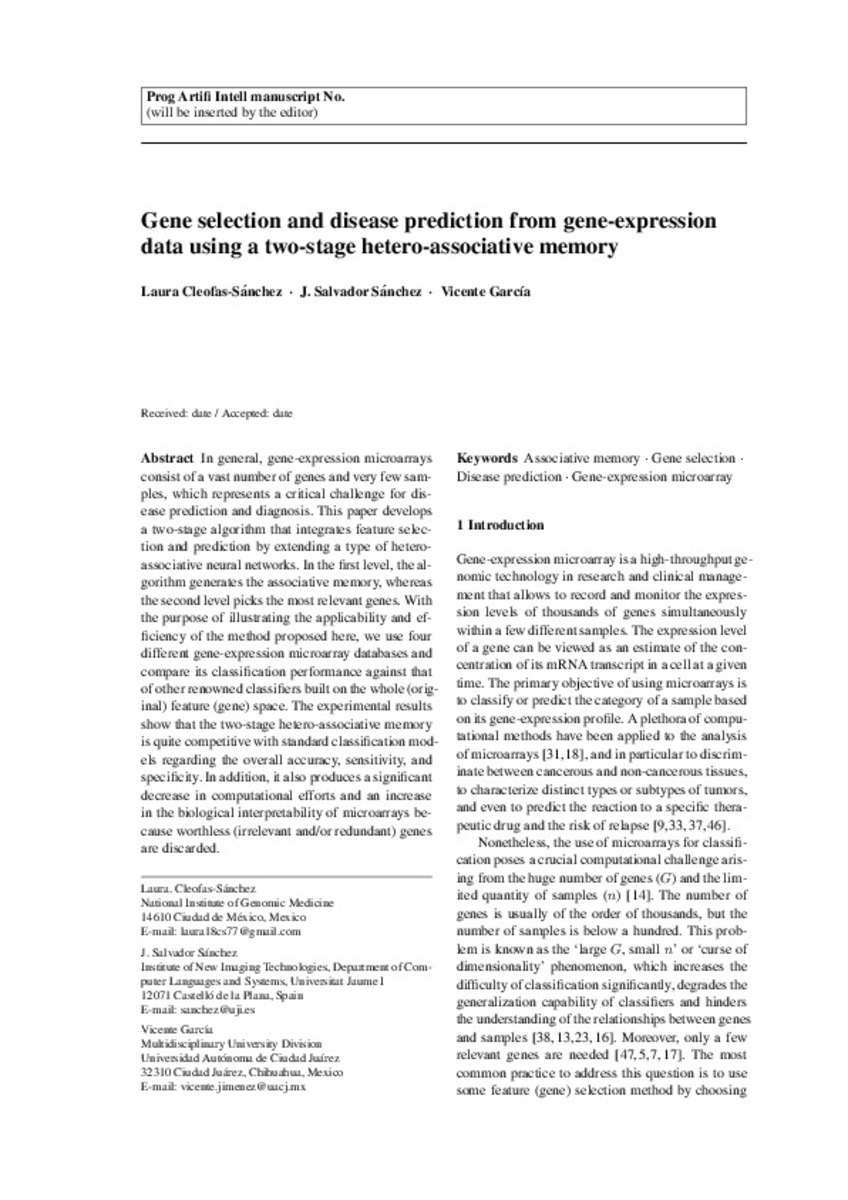Mostrar el registro sencillo del ítem
Gene selection and disease prediction from gene expression data using a two-stage hetero-associative memory
| dc.contributor.author | Cleofás Sánchez, Laura | |
| dc.contributor.author | Sánchez Garreta, Josep Salvador | |
| dc.contributor.author | García, Vicente | |
| dc.date.accessioned | 2019-06-14T10:27:17Z | |
| dc.date.available | 2019-06-14T10:27:17Z | |
| dc.date.issued | 2019 | |
| dc.identifier.citation | CLEOFAS-SÁNCHEZ, Laura; SÁNCHEZ, J. Salvador; GARCÍA, Vicente. Gene selection and disease prediction from gene expression data using a two-stage hetero-associative memory. Progress in Artificial Intelligence, 2019, vol. 8, no 1, p. 63-71. | ca_CA |
| dc.identifier.issn | 2192-6360 | |
| dc.identifier.uri | http://hdl.handle.net/10234/182827 | |
| dc.description.abstract | In general, gene expression microarrays consist of a vast number of genes and very few samples, which represents a critical challenge for disease prediction and diagnosis. This paper develops a two-stage algorithm that integrates feature selection and prediction by extending a type of hetero-associative neural networks. In the first level, the algorithm generates the associative memory, whereas the second level picks the most relevant genes.With the purpose of illustrating the applicability and efficiency of the method proposed here, we use four different gene expression microarray databases and compare their classification performance against that of other renowned classifiers built on the whole (original) feature (gene) space. The experimental results show that the two-stage hetero-associative memory is quite competitive with standard classification models regarding the overall accuracy, sensitivity and specificity. In addition, it also produces a significant decrease in computational efforts and an increase in the biological interpretability of microarrays because worthless (irrelevant and/or redundant) genes are discarded. | ca_CA |
| dc.format.extent | 10 p. | ca_CA |
| dc.format.mimetype | application/pdf | ca_CA |
| dc.language.iso | eng | ca_CA |
| dc.publisher | Springer Verlag | ca_CA |
| dc.relation.isPartOf | Progress in Artificial Intelligence, 8, 2019. | ca_CA |
| dc.rights | © Springer-Verlag GmbH Germany, part of Springer Nature 2018. “This is a post-peer-review, pre-copyedit version of an article published in Progress in Artificial Intelligence. The final authenticated version is available online at: https://doi.org/10.1007/s13748-018-0148-6” | ca_CA |
| dc.rights.uri | http://rightsstatements.org/vocab/InC/1.0/ | * |
| dc.subject | Associative memory | ca_CA |
| dc.subject | Gene selection | ca_CA |
| dc.subject | Disease prediction | ca_CA |
| dc.subject | Gene expression microarray | ca_CA |
| dc.title | Gene selection and disease prediction from gene expression data using a two-stage hetero-associative memory | ca_CA |
| dc.type | info:eu-repo/semantics/article | ca_CA |
| dc.identifier.doi | https://doi.org/10.1007/s13748-018-0148-6 | |
| dc.relation.projectID | PROME-TEOII/2014/062 ; DSA/103.5/15/7004 ; TIN2013-46522-P. | ca_CA |
| dc.rights.accessRights | info:eu-repo/semantics/openAccess | ca_CA |
| dc.relation.publisherVersion | https://link.springer.com/article/10.1007/s13748-018-0148-6 | ca_CA |
| dc.date.embargoEndDate | 2020-04-30 | |
| dc.type.version | info:eu-repo/semantics/acceptedVersion | ca_CA |
Ficheros en el ítem
Este ítem aparece en la(s) siguiente(s) colección(ones)
-
INIT_Articles [747]
-
LSI_Articles [362]
Articles de publicacions periòdiques escrits per professors del Departament de Llenguatges i Sistemes Informàtics







